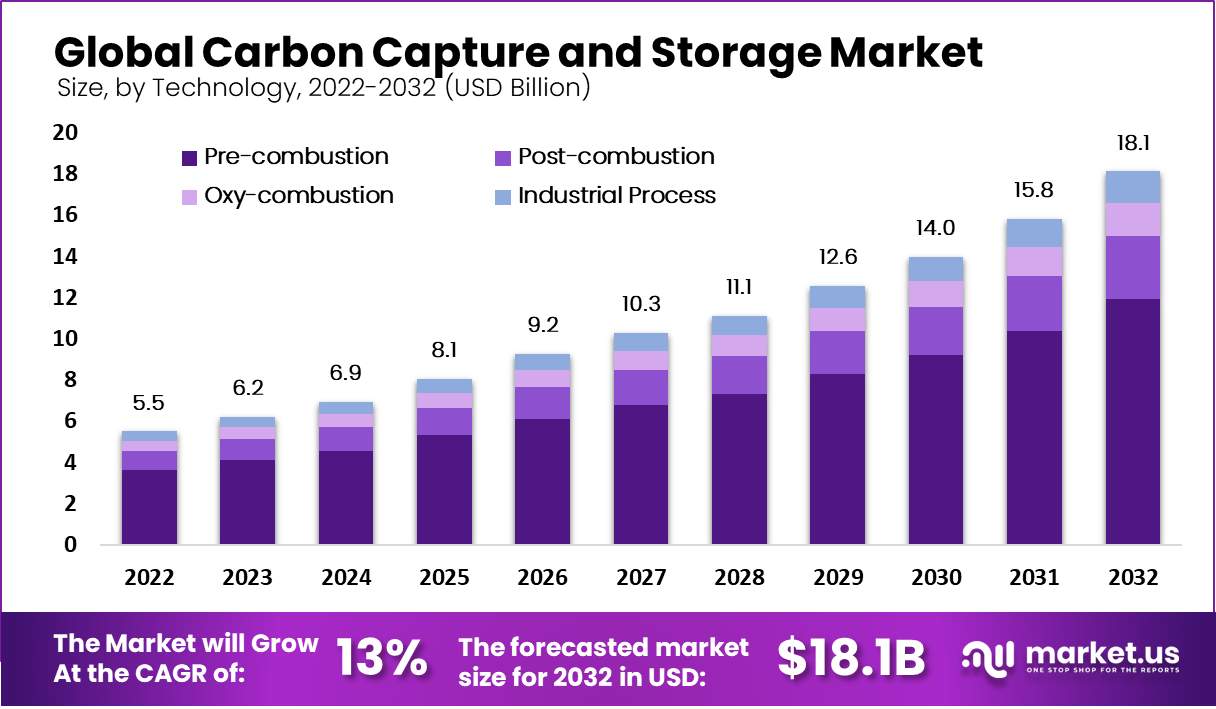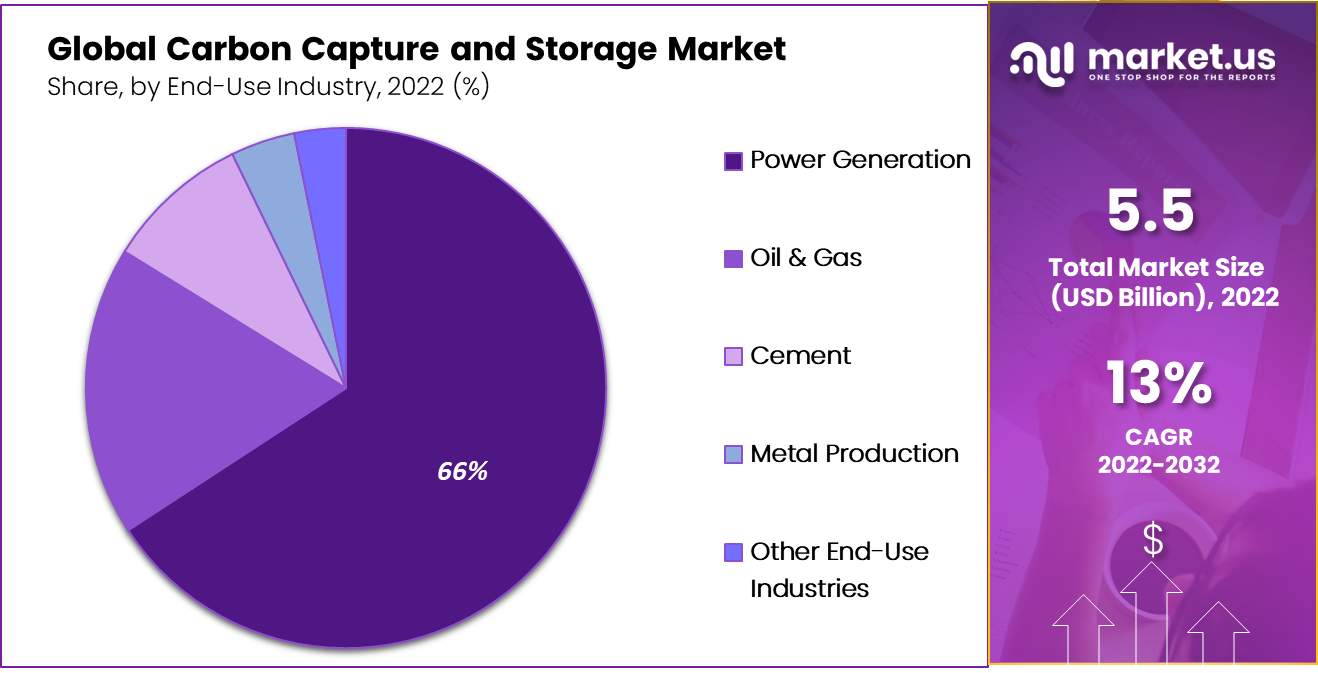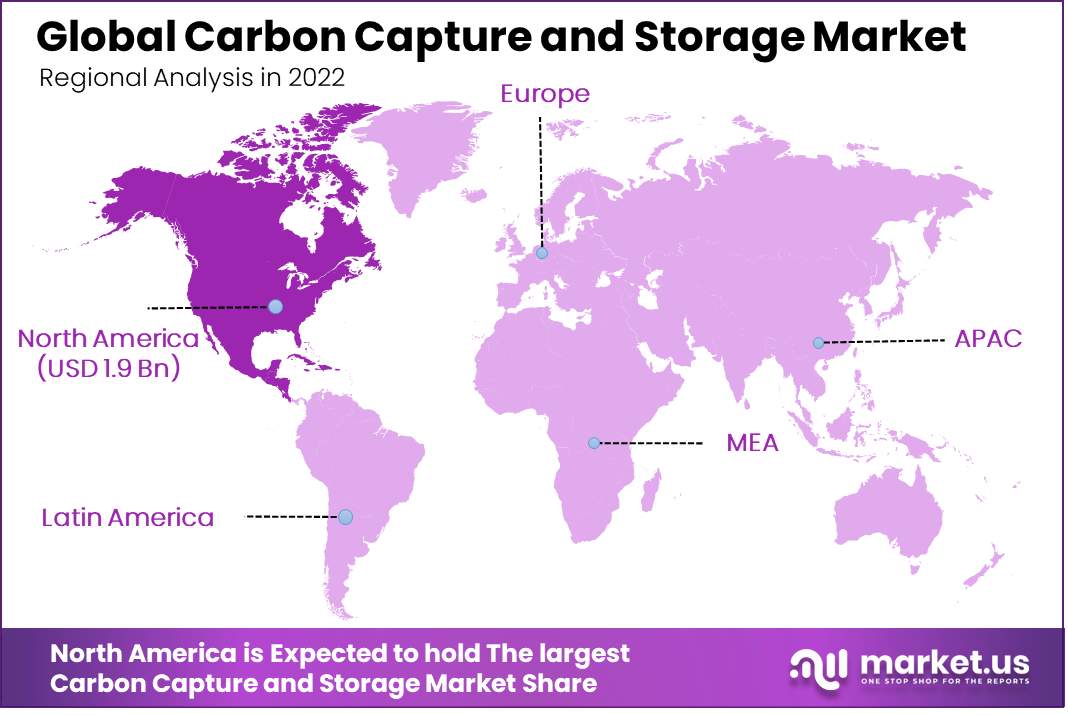New York, Jan. 29, 2024 (GLOBE NEWSWIRE) -- According to Market.us, The Carbon Capture and Storage Market was valued at USD 5.5 Billion in 2023 with significant growth and is projected to reach USD 18.1 Billion by 2033 with an outstanding CAGR of 13%.
Carbon Capture and Storage (CCS) refers to a set of technologies and processes designed to capture carbon dioxide (CO2) emissions from sources like power plants and industrial facilities. The captured CO2 is then transported, usually via pipelines, and stored or "sequestered" in geological formations underground, such as depleted oil and gas fields or deep saline aquifer formations, to prevent its release into the atmosphere. The primary aim of CCS is to mitigate climate change by reducing greenhouse gas emissions, specifically CO2, which is a major contributor to global warming. This technology is considered crucial for achieving net-zero emissions targets, particularly in industries that are difficult to decarbonize, such as cement, steel, and chemical production.
To Gain greater insights, Request a sample report@ https://market.us/report/carbon-capture-and-storage-market/request-sample/

Key Takeaways
- The global CCS market was valued at USD 5.5 billion in 2023, with a projected CAGR of 13% from 2023 to 2032.
- CCS captures and stores carbon emissions from fossil-fuel-powered industries and plants to reduce environmental impact.
- Rising environmental awareness boosts CCS adoption, with gas injection EOR techniques enhancing market trends.
- Safety risks like soil acidification and high investment costs hinder CCS adoption, especially for smaller companies.
- Precombustion technology dominates CCS applications with a 65.8% share, favored for its energy efficiency and CO2 capture capabilities.
- Power generation led the CCS end-use industry, contributing 64.6% of the revenue, driven by strict emission regulations.
- Technological advancements in CCS offer significant growth opportunities across the industry.
- Various national governments actively promote CCS technology, supporting market growth and innovation.
- The shift towards natural gas, with lower emissions than oil and coal, increases demand for CCS.
- North America leads the CCS market with a 35.8% revenue share, driven by strong oil and gas demand and stringent emission regulations
Factors affecting the growth of the Carbon Capture and Storage Market
- Technological Advancements: The development and deployment of advanced, cost-effective, and efficient CCS technologies significantly impact market growth. Innovations that reduce the cost of capture, enhance the safety and efficiency of CO2 transport and ensure reliable storage are key drivers.
- Economic Factors: The economic viability of CCS projects is a critical determinant of market growth. This includes the cost of technology, infrastructure development, and operational expenses. Factors such as the availability of funding, investment from governments and private entities, and the potential revenue streams from using captured CO2 (e.g., in enhanced oil recovery) also play significant roles.
- Regulatory and Policy Framework: Government policies, regulations, and incentives are pivotal in driving the CCS market. Policies that impose carbon taxes or establish emissions trading schemes create a financial impetus for adopting CCS. Subsidies, grants, and other forms of governmental support can also accelerate the deployment of CCS technologies.
- Environmental and Climate Change Concerns: Increasing awareness and concern regarding climate change and the urgency to reduce greenhouse gas emissions are significant motivators for CCS market growth. Commitments by countries and corporations to achieve net-zero emissions targets bolster the development of CCS projects.
- Energy and Industrial Sector Dynamics: The demand for CCS in industries with high CO2 emissions, such as power generation, cement, steel, and chemical manufacturing, directly affects market growth. The transition of the energy sector towards more sustainable practices, including the use of CCS in fossil fuel-based energy production, is a vital factor.
Top Trends in the Global Carbon Capture and Storage Market
- Increased Government Support and Policy Initiatives: Governments around the world are increasingly recognizing the importance of CCS in achieving climate goals. This recognition is translating into supportive policies, regulatory frameworks, and financial incentives. Initiatives like carbon pricing, tax credits (such as the 45Q tax credit in the United States), and direct funding for CCS projects are becoming more common.
- Integration with Renewable Energy Projects: There is a growing trend of integrating CCS with renewable energy projects, such as bioenergy with carbon capture and storage (BECCS). This integration not only captures CO2 emissions but also can result in negative emissions, which are crucial for achieving net-zero targets.
- Advancements in Capture and Storage Technologies: Technological innovation remains a key trend. Improvements in capture technologies, aimed at reducing energy consumption and increasing efficiency, are ongoing. Additionally, there is a growing focus on developing more secure and efficient CO2 storage solutions, including the exploration of new geological storage sites.
- Expansion in Emerging Markets: Initially concentrated in developed countries, CCS is increasingly being explored in emerging markets. Countries like China and India, with their significant industrial emissions, are beginning to invest in CCS technology as part of their sustainability strategies.
- Industrial Utilization of Captured CO2: Utilizing captured CO2 for commercial purposes, such as in enhanced oil recovery (EOR) or in the production of chemicals and construction materials, is gaining traction. This not only provides a revenue stream to offset CCS costs but also contributes to a circular carbon economy.
Market Dynamics
Driving Factor
The global Carbon Capture and Storage (CCS) market is experiencing significant growth, primarily driven by escalating environmental concerns and the rising need to mitigate carbon emissions. The rapid pace of industrialization and urbanization globally has led to increased emissions, prompting heightened environmental awareness and the adoption of CCS as a sustainable solution. This technology, which captures and securely stores CO2, is being increasingly recognized as essential for environmental protection.
Additionally, advancements in the oil and gas industries have further spurred CCS market growth. The application of captured carbon in Enhanced Oil Recovery (EOR) techniques, particularly gas injection methods for both onshore and offshore oil extraction, is gaining traction. With the depletion of oil reservoirs, the demand for such EOR techniques, which utilize CO2 for crude oil extraction, is expected to rise notably, thereby fueling the expansion of the CCS market.
Restraining Factor
The growth of the global Carbon Capture and Storage (CCS) market is hindered by significant safety concerns and the high cost of technology. Key challenges include risks associated with underground CO2 storage, such as potential soil acidification, water contamination, cryogenic burns, and alterations in groundwater quality. These risks necessitate stringent monitoring and precautionary measures, adding complexity to CCS projects.
Furthermore, the substantial investment required for CCS technology, encompassing various intricate processes, presents a financial barrier. This high cost particularly affects the adoption of CCS by small and medium-sized enterprises, as it can be prohibitively expensive for these organizations to implement CCS in their operations.
Growth Opportunity
The global Carbon Capture and Storage (CCS) market is poised for growth, driven by technological advancements and robust government initiatives. The evolution of CCS technologies has led to a surge in projects, especially in Asia, where countries like China and Australia are early adopters, integrating CCS into key industries such as oil and gas.
These advancements are anticipated to open numerous opportunities in the CCS sector globally. Additionally, increasing governmental support, through various initiatives and policies, is encouraging more companies to embrace CCS. This supportive environment is expected to further enhance the opportunities available in the global CCS market during the forecast period.
Buy Now this Premium Report to Grow your Business: https://market.us/purchase-report/?report_id=37076
Report Segmentation of Global Carbon Capture and Storage Market
By Technology Analysis
In the global Carbon Capture and Storage (CCS) market, segmented by technology, pre-combustion capture dominates, accounting for a significant revenue share of 65.8%. This dominance is driven by the growing adoption of pre-combustion technology for efficient CO2 capture, utilizing processes like the water gas shift reaction followed by acid gas removal.
The technology's comparative advantage in terms of lower energy penalties and higher CO2 capture efficiency has been pivotal in bolstering its growth and prominence within the CCS technology segment.
By End-Use Industry Analysis
In the global Carbon Capture and Storage (CCS) market, power generation emerges as the leading end-use industry, holding a dominant revenue share of 64.6%. This significant share is primarily attributed to the high carbon emissions from coal-fired power plants. In response to this, stringent governmental regulations have been implemented, mandating the reduction of carbon emissions in the power sector.
Consequently, numerous companies within power generation are increasingly adopting CCS operations, thereby driving the growth of this segment in the CCS market.

Key Market Segments
By Technology
- Pre-combustion
- Post-combustion
- Oxy-combustion
- Industrial Process
By End-Use Industry
- Power Generation
- Oil & Gas
- Metal Production
- Cement
- Other End-Use Industries
Want to Access the Statistical Data and Graphs, Request a PDF Sample @ https://market.us/report/carbon-capture-and-storage-market/request-sample/
Competitive Landscape
The competitive landscape of the market has also been examined in this report. Some of the major players include:
- Siemens AG
- Aker Solutions
- Dakota Gasification Company
- Fluor Corp.
- Linde plc
- Mitsubishi Heavy Industries Ltd.
- Equinor ASA
- Royal Dutch Shell PLC
- Sulzer Ltd.
- Exxon Mobil Corporation
- Other Key Players
Scope of the Report
| Report Attributes | Details |
| Market Value (2023) | USD 6.2 Billion |
| Forecast Revenue 2032 | USD 18.1 billion |
| CAGR (2023 to 2032) | 13% |
| North America Revenue Share | 35.8% |
| Base Year | 2023 |
| Historic Period | 2018 to 2022 |
| Forecast Year | 2023 to 2032 |
Regional Analysis
North America currently leads the global Carbon Capture and Storage (CCS) market, holding a substantial revenue share of 35.8%. This dominant position is largely due to the region's escalating demand for oil and gas, combined with strict governmental regulations aimed at reducing carbon emissions. The United States and Canada are particularly significant in this market, with numerous key companies initiating CCS projects.
The region's focus on environmental concerns has led to the implementation of stringent regulations to control carbon emissions, thereby fueling the growth of the CCS market in North America. Following North America, Europe occupies the second-largest share in the market. The growth in Europe is driven by an increase in CCS projects, leveraging innovative technologies, which is significantly contributing to the region's prominence in the global CCS landscape.

By Geography
- North America
- The US
- Canada
- Europe
- Germany
- France
- The UK
- Spain
- Italy
- Russia
- Netherland
- Rest of Europe
- APAC
- China
- Japan
- South Korea
- India
- Australia
- New Zealand
- Singapore
- Thailand
- Vietnam
- Rest of APAC
- Latin America
- Brazil
- Mexico
- Rest of Latin America
- Middle East & Africa
- South Africa
- Saudi Arabia
- UAE
- Rest of MEA
Browse More Related Reports
- Aramid Fiber market size is expected to be worth around USD 10.4 billion by 2033, from USD 4.9 billion in 2023, growing at a CAGR of 7.8% during the forecast period from 2023 to 2033.
- Printing Ink Market size was valued at USD 21.2 billion and is expected to grow to around USD 30 billion by 2032 between 2023 and 2032, this market is estimated to register the highest CAGR of 3.8%.
- Advanced Ceramics Market size is expected to be worth around USD 19.9 billion by 2033, from USD 11.2 billion in 2023, growing at a CAGR of 6.1% during the forecast period from 2023 to 2033.
- Green Chemicals Market was valued at USD 100.9 billion and is expected to reach USD 274.2 Billion in 2032, Between 2022 and 2032, this market is estimated to register a CAGR of 10.8%.
- Phenolic Resin market size is expected to be worth around USD 18.9 billion by 2033, from USD 12.67 billion in 2023, growing at a CAGR of 4.1% during the forecast period from 2023 to 2033.
- Geosynthetics market size is expected to be worth around USD 24.1 billion by 2033, from USD 12.7 billion in 2023, growing at a CAGR of 6.6% during the forecast period from 2023 to 2033.
- Acrylic Foam Tape Market was valued at USD 2.1 Billion, is projected to reach USD 6.95 billion in 2032 and from 2023 to 2032, this market is estimated to register a CAGR of 7.4%.
- Agricultural Films Market size is expected to be worth around USD 21.2 billion by 2033, from USD 11.7 billion in 2023, growing at a CAGR of 6.1% during the forecast period from 2023 to 2033.
- Aroma Chemicals market size is expected to be worth around USD 9.2 billion by 2033, from USD 5.6 billion in 2023, growing at a CAGR of 5.1% during the forecast period from 2023 to 2033.
- Furfural market size is expected to be worth around USD 1012.6 Million by 2033, from USD 576.2 Million in 2023, growing at a CAGR of 5.8% during the forecast period from 2023 to 2033.
About Us
Market.US (Powered by Prudour Pvt Ltd) specializes in in-depth market research and analysis and has been proving its mettle as a consulting and customized market research company, apart from being a much sought-after syndicated market research report-providing firm. Market.US provides customization to suit any specific or unique requirement and tailor-makes reports as per request. We go beyond boundaries to take analytics, analysis, study, and outlook to newer heights and broader horizons.
Follow Us On LinkedIn Facebook Twitter
Our Blog:
